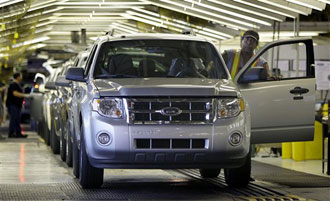Manufacturers Lead Growth With Broad-Based Gains
By wchung | 11 Sep, 2025
Signaling that manufacturers are leading the economy into a recovery, output from the nation’s factories, mines and utilities posted widespread gains in August.
In a further dose of good news, inflation remained essentially nonexistent as prices scarcely rose last month.
The August gains in industrial production marked the second straight increase after the global recession dried up the appetites of customers worldwide. Output rose 0.8 percent, the Federal Reserve said Wednesday, beating analysts’ estimates.
In part, the improvement reflected auto sales that were boosted by the government’s now-ended Cash for Clunkers program. But analysts were impressed that output rose broadly across industries.
“Vehicles are not the whole story,” Nigel Gault, chief U.S. economist at IHS Global Insight, said in a note to clients.
Gault noted that production rose in five out of 10 categories of durable goods, including machinery and electrical equipment.
The pace of growth is expected to slow later this year. That’s partly because the stimulative effect of the clunkers program, which issued rebates for people who traded in older gas-guzzlers for new, fuel-efficient models, will fade.
But industrial stockpiles are so low that production should keep rising even as consumer spending remains weak, economists said. Companies had cut their stockpiles by a record $159.2 billion in the second quarter. Low inventories tend to signal higher output ahead, because companies eventually must produce more to refill their depleted stockpiles.
Manufacturers “are in a catch-up mode right now,” Gault said. “They’re adjusting for the fact that the level of demand didn’t meet their worst fears.”
Factory output, the single-biggest slice of overall industrial activity, also rose for the second straight month.
Auto production led the way, rising 5.5 percent in August. That followed a whopping 20.1 percent gain in July, when General Motors and Chrysler reopened many plants that had been closed as the companies restructured and emerged from bankruptcy.
Yet even with autos and parts stripped out, manufacturing activity gained 0.4 percent last month. Production of steel, aluminum and other metals rose 0.9, while electrical equipment and appliances output also increased.
Despite the recent gains, industrial companies are still operating well below capacity. The operating rate in August was 69.6 percent, under the 80 percent consistent with a healthy economy.
Manufacturing output will likely grow more slowly later this year as the clunkers’ impact wears off, said Daniel Meckstroth, chief economist for the Manufacturers Alliance/MAPI, a business research group.
“We only expect a modest pace of recovery because of the headwinds” that debt-laden consumers face, he said, meaning sluggish spending is likely for months.
Consumer spending, which accounts for about 70 percent of the economy, is forecast by many economists to grow weakly next year.
Shoppers are holding back in the face of job losses, stagnant incomes and tight credit. That contrasts with the early stages of other recent recoveries. Consumer spending soared more than 5 percent in 1983, for example, after the deep 1981-82 recession. It also jumped after the 1990-1991 downturn.
Growth in other areas could pick up some of the slack in consumer spending. Manufacturers have been aided by recent increases in exports, as economies in Europe and Asia rebound. Business investment also shows signs of improving.
Inflation, meanwhile, remains nowhere in sight. The Consumer Price Index rose just 0.4 percent in August, after a flat reading in July, the government said. Prices fell 1.5 percent in the past year, as gas prices dropped sharply from record levels last summer.
The “core” CPI, which excludes volatile food and energy prices, ticked up a scant 0.1 percent, matching expectations. Over the 12 months ending in August, the core rate rose 1.4 percent — the smallest such increase in more than five years.
That means the Fed faces no pressure to raise its benchmark interest rate, a step it would take to ward off high inflation. The Fed has reduced the rate it charges banks for overnight loans to a record low of nearly zero to try to revive the economy.
“The inflation numbers today suggest that the consumer doesn’t have a reason … to fear spending,” said Bruce Shalett, managing partner at Wynston Hill Capital.
The strength in industrial production helped encourage investors to bet that the economy is recovering. The Dow Jones industrial average surged more than 108 points, or 1.1 percent, to 9,791.71, and other stock averages also rose.
The National Association of Home Builders said its housing market index rose in September, reflecting growing optimism in the industry about rising home sales.
On Tuesday, Fed Chairman Ben Bernanke said the recession is likely over, though he noted that the economy isn’t likely to grow fast enough to lower unemployment anytime soon. Most economists expect the jobless rate to top 10 percent next year, up from its current 9.7 percent.
Separately, the deficit in the broadest measure of foreign trade shrank in the spring to the lowest level relative to the total economy in 10 years. The figure showed how much the recession reduced America’s appetite for foreign goods.
Meanwhile, foreign demand for long-term U.S. financial assets fell in July, but China boosted its holdings, the Treasury Department said.
9/16/2009 4:19 PM CHRISTOPHER S. RUGABER, JEANNINE AVERSA,AP Economics Writers WASHINGTON

New Escape SUVs roll off the line at Ford's Kansas City Assembly Plant in Claycomo, Mo. (AP Photo/Charlie Riedel)
Asian American Success Stories
- The 130 Most Inspiring Asian Americans of All Time
- 12 Most Brilliant Asian Americans
- Greatest Asian American War Heroes
- Asian American Digital Pioneers
- New Asian American Imagemakers
- Asian American Innovators
- The 20 Most Inspiring Asian Sports Stars
- 5 Most Daring Asian Americans
- Surprising Superstars
- TV’s Hottest Asians
- 100 Greatest Asian American Entrepreneurs
- Asian American Wonder Women
- Greatest Asian American Rags-to-Riches Stories
- Notable Asian American Professionals

